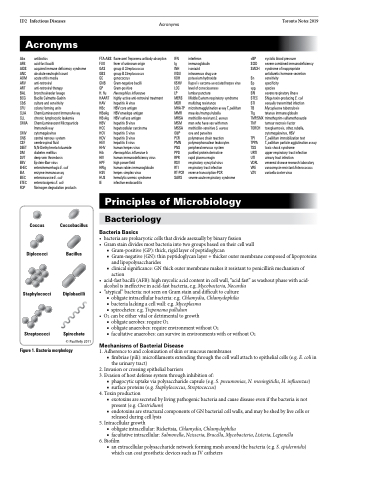Page 602 - TNFlipTest
P. 602
ID2 Infectious Diseases Acronyms
Abx antibiotics
AFB acid-fast bacilli
AIDS acquired immune deficiency syndrome ANC absolute neutrophil count
AOM acute otitis media
ARV anti-retroviral
ART anti-retroviral therapy
BAL bronchoalveolar lavage
BCG Bacille Calmette-Guérin
C&S culture and sensitivity
CFU colony forming units
CLIA ChemiLuminescent ImmunoAssay CLL chronic lymphocytic leukemia
CMIA ChemiLuminescent Microparticle
ImmunoAssay CMV cytomegalovirus
CNS central nervous system CSF cerebrospinal fluid
DEET N,N-Diethyl-meta-toluamide DM diabetes mellitus
Acronyms
FTA-ABS fluorescentTreponemaantibody-absorption IFN
Toronto Notes 2019
DVT deep vein thrombosis
EBV Epstein-Barr virus
EHEC enterohemorrhagic E. coli
EIA enzyme immunoassay
EIEC enteroinvasive E. coli
ETEC enterotoxigenic E. coli IE
FDP
Staphylococci
Streptococci
fibrinogen degradation products
FUO GAS GBS GC GNB GP
H. flu HAART HAV HBc HBeAg HBsAg HBV HCC HCV HDV HEV HHV Hib HIV HPF HRIg HSV HUS
fever of unknown origin Ig group A Streptococcus INH group B Streptococcus IVDU gonococcus KOH Gram-negative bacilli KSHV Gram-positive LOC Haemophilus influenzae LP highly active anti-retroviral treatment MERS hepatitis A virus MDR HBV core antigen MHA-TP HBV envelope antigen MMR HBV surface antigen MRSA hepatitis B virus MSM hepatocellular carcinoma MSSA hepatitis C virus O&P hepatitis D virus PCR hepatitis E virus PMN human herpes virus PNS Haemophilus influenzae b PPD human immunodeficiency virus RPR high power field RSV human rabies immunoglobulin RTI herpes simplex virus RT-PCR hemolytic uremic syndrome SARS infective endocarditis
interferon
immunoglobulin
isoniazid
intravenous drug use
potassium hydroxide
Kaposi’s sarcoma-associated herpes virus level of consciousness
lumbar puncture
Middle Eastern respiratory syndrome multidrug resistance microhemagglutination assay T. pallidum measles/mumps/rubella methicillin-resistant S. aureus
men who have sex with men methicillin-sensitive S. aureus
ova and parasites
polymerase chain reaction polymorphonuclear leukocytes peripheral nervous system
purified protein derivative
rapid plasma reagin
respiratory syncytial virus
respiratory tract infection
reverse transcription-PCR
severe acute respiratory syndrome
sBP systolic blood pressure
SCID severe combined immunodeficiency SIADH syndrome of inappropriate
antidiuretic hormone secretion Sn sensitivity
Sp specificity
spp. species
SRI severe respiratory illness STEC Shiga toxin-producing E. coli STI sexually transmitted infection TB Mycoplasma tuberculosis
TIg tetanus immune globulin TMP/SMX trimethoprim-sulfamethoxazole TNF tumour necrosis factor
TORCH toxoplasmosis, other, rubella,
cytomegalovirus, HSV
TPI T. pallidum immobilization test
TPPA T. pallidum particle agglutination assay TSS toxic shock syndrome
URTI upper respiratory tract infection
UTI urinary tract infection
VDRL venereal disease research laboratory VRE vancomycin-resistant Enterococcus VZV varicella-zoster virus
Coccus
Diplococci
Coccobacillus
Bacillus
Diplobacilli
Spirochete
© Paul Kelly 2011
Principles of Microbiology
Bacteriology
Bacteria Basics
Figure 1. Bacteria morphology
• bacteriaareprokaryoticcellsthatdivideasexuallybybinaryfission
• Gramstaindividesmostbacteriaintotwogroupsbasedontheircellwall
■ Gram-positive (GP): thick, rigid layer of peptidoglycan
■ Gram-negative (GN): thin peptidoglycan layer + thicker outer membrane composed of lipoproteins
and lipopolysaccharides
■ clinical significance: GN thick outer membrane makes it resistant to penicillin’s mechanism of
action
• acid-fastbacilli(AFB):highmycolicacidcontentincellwall,“acidfast”aswashoutphasewithacid-
alcohol is ineffective in acid-fast bacteria, e.g. Mycobacteria, Nocardia
• “atypical”bacteria:notseenonGramstainanddifficulttoculture ■ obligate intracellular bacteria: e.g. Chlamydia, Chlamydophilia
■ bacteria lacking a cell wall: e.g. Mycoplasma
■ spirochetes: e.g. Treponema pallidum
• O2canbeeithervitalordetrimentaltogrowth
■ obligate aerobes: require O2
■ obligate anaerobes: require environment without O2
■ facultative anaerobes: can survive in environments with or without O2
Mechanisms of Bacterial Disease
1. Adherence to and colonization of skin or mucous membranes
■ fimbriae (pili): microfilaments extending through the cell wall attach to epithelial cells (e.g. E. coli in
the urinary tract)
2. Invasion or crossing epithelial barriers
3. Evasion of host defense system through inhibition of:
■ phagocytic uptake via polysaccharide capsule (e.g. S. pneumoniae, N. meningitidis, H. influenzae)
■ surface proteins (e.g. Staphylococcus, Streptococcus) 4. Toxin production
■ exotoxins are secreted by living pathogenic bacteria and cause disease even if the bacteria is not present (e.g. Clostridium)
■ endotoxins are structural components of GN bacterial cell walls, and may be shed by live cells or released during cell lysis
5. Intracellular growth
■ obligate intracellular: Rickettsia, Chlamydia, Chlamydophilia
■ facultative intracellular: Salmonella, Neisseria, Brucella, Mycobacteria, Listeria, Legionella
6. Biofilm
■ an extracellular polysaccharide network forming mesh around the bacteria (e.g. S. epidermidis)
which can coat prosthetic devices such as IV catheters


